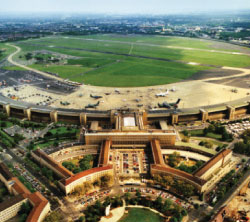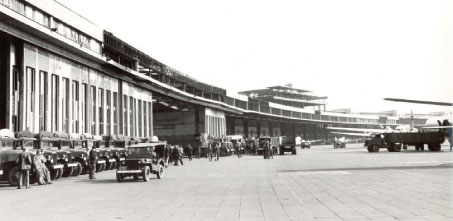
Tempelhof was designed by architect Ernst Sagebiel and composed of three integral parts: the passenger terminal proper, a crescent-shaped airside structure that comprises a covered apron area with hangars to either side, and landside office buildings to either side of the terminal’s main entrances.
At the time of its designation by the Ministry of Transport in 1923, Tempelhof Airport was the one of greatest architectural undertakings in modern history, ultimately becoming classified as one of the largest buildings in the world. Berlin’s popularity as a destination soared in the late 1920’s and early 1930’s, with Tempelhof handling 29,991 passengers in 1927, increasing exponentially to 200,000 passengers a year by 1936. It also set an impressively early example of intermodality, by becoming the world’s first airport with an underground railway station in 1927.
However, it was the role played by Tempelhof during the Soviet blockade (26 June 1948 to 6 May 1949) that secured the airport’s place in the hearts and minds of so many people. “In this time, during the Berlin Airlift, the freedom of West Berlin was saved. Unforgotten is Gail Halvorsen, the Douglas C-54 Skymaster pilot who started with his famous Rosinenbombers the widespread practice of dropping chocolates on tiny parachutes for the city’s children who would gather around Tempelhof Airport during the blockade,” said Ralf Kunkel, head of press, Berlin Airports.
In the gallery of international airports, Tempelhof is justifiably viewed as iconic. Its groundbreaking design continues to influence generations of architects. It was designed by architect Ernst Sagebiel and composed of three integral parts: the passenger terminal proper, a crescent-shaped airside structure that comprises a covered apron area with hangars to either side, and landside office buildings to either side of the terminal’s main entrances. The terminal itself is T-shaped, with its head toward landside.
“The curved airside structure is perhaps Tempelhof’s most outstanding feature. In the shape of a 1,230m geometric arc, it forms a third of a circle. This is covered by a cantilevered roof, with a free inside height of 12.2m, extending as an uninterrupted sweep over the structure’s entire length,” said Kunkel.
The magnificent structure has been used as a location in many films, notably Indiana Jones and the Last Crusade and Billy Wilder’s Eins, Zwei, Drei.

From 26 June 1948 to 6 May 1949 during the Soviet blockade, Tempelhof assumed an important role for the residents of West Berlin. “In this time, during the Berlin Airlift, the freedom of West Berlin was saved,” said Ralf Kunkel, head of press, Berlin Airports.
‘End of a significant era’
In terms of air traffic policy, the goal of the states of Berlin and Brandenburg is to concentrate the region’s entire air traffic in one location. With the opening of Berlin Brandenburg International (BBI) on 30 October 2011, the historical split of the capital’s air traffic will come to an end. The closure of Tempelhof is an important milestone in the realisation of BBI. Tegel, the city’s second airport, will be closed after the opening of BBI.
The last flights are the highlight of the final event to mark the closure of Tempelhof, to which Berlin Airports is inviting representatives of airlines and personalities from politics and economics. On the last day, the main hall will be closed to visitors and people collecting passengers; travellers with a valid air ticket for this day will have access to the main hall as usual. “The last flights mark the end of a significant era in German aviation history. At the same time, with the closure of the airport, Berlin Airports is taking a big step towards the realisation of the most important future project of the German metropolitan region: the concentration of the air traffic at the new Capital Airport Berlin Brandenburg International BBI by 2011,” said Kunkel.
The Senat of Berlin is responsible for the Tempelhof building and surrounding area after its closure. Public discussions are taking place concerning the future of the 450ha site. One proposal is to build modern apartments with parks and playgrounds for children.
Construction of a new international airport solves the costly and inefficient fragmentation of the region’s air travel market. “BBI will be a new opportunity for the region. The improved infrastructure will facilitate ongoing structural change in the region, and stimulate further growth. In addition, the tourism, convention and trade fair industries stand to gain substantially,” said Kunkel.
BBI, with its strong focus on European destinations and long-haul routes to the Americas and Asia, will considerably strengthen the region’s transportation system. It will provide Germany’s capital region with the air travel capacity required in the coming decades.







